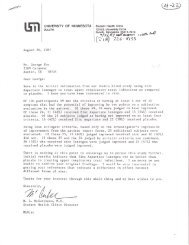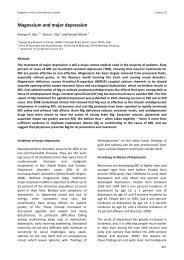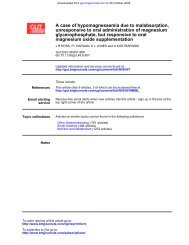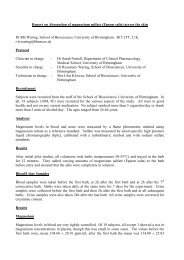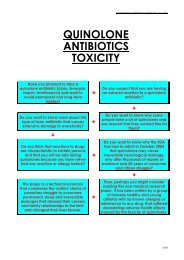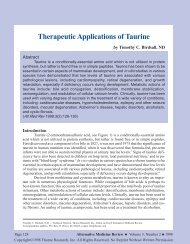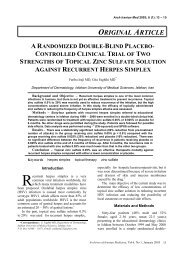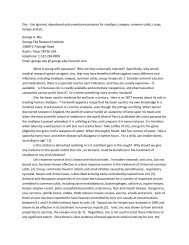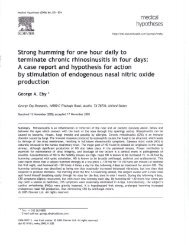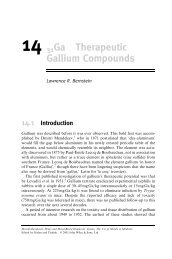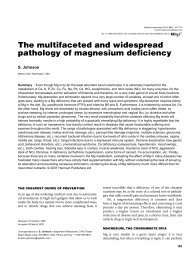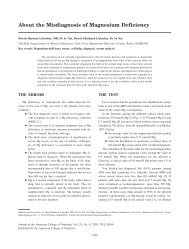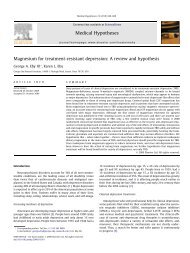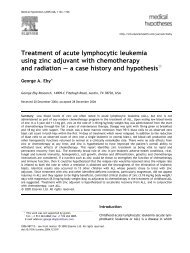Zinc Lozenges: Cold Cure or Candy? - Bioscience Reports
Zinc Lozenges: Cold Cure or Candy? - Bioscience Reports
Zinc Lozenges: Cold Cure or Candy? - Bioscience Reports
You also want an ePaper? Increase the reach of your titles
YUMPU automatically turns print PDFs into web optimized ePapers that Google loves.
36 Eby<br />
Turner [40] questioned the rational f<strong>or</strong> intra-<strong>or</strong>al administration of zinc rather<br />
than intranasal zinc. Intra-<strong>or</strong>al administration can be seen as the proper means of<br />
administration only when one considers biophysical effects. In partial answer to<br />
Turner’s question, N<strong>or</strong>denstro¨m extensively and th<strong>or</strong>oughly documented long-range<br />
biologically closed electric circuits (BCEC) in humans in 1983 [41].<br />
M<strong>or</strong>e completely answering Turner’s question, a mouth–nose BCEC was described<br />
by Eby [4]. The mouth–nose BCEC can be observed by placing a lead of a<br />
digital voltmeter in the mouth and the other lead in the nasal cavity. This circuit has<br />
been shown to produce a 60–120 mV potential difference [4]. In treatment of colds<br />
with zinc lozenges, this writer believes that electrons from the mouth–nose BCEC<br />
transp<strong>or</strong>t iZn from the mouth into the nasopharyngeal and nasal tissues in much the<br />
same way that electrons c<strong>or</strong>rode metal away from an electric battery terminal.<br />
Neutrally and negatively charged zinc species from the mouth are not transp<strong>or</strong>ted by<br />
the BCEC into nasal–pharyngeal <strong>or</strong> nasal tissues. Even if they were, they have no<br />
known biological function in treating colds.<br />
On the other hand, positively charged substances, such as zinc ions, applied on<br />
top of the nasal mucous are repelled by electrons flowing from the mouth outward<br />
through the nasal and nasal pharyngeal tissues, causing them to be expelled by the<br />
mucous and down into the throat. The mouth–nose BCEC also suggests no possibility<br />
f<strong>or</strong> meaningfully reducing the duration of colds using intra-nasal zinc without<br />
electricity to reverse the mouth–nose BCEC.<br />
In 1931, reversing the mouth–nose BCEC using intra-nasally applied direct<br />
current with zinc sulfate soaked nasal packings resulted in very long lasting (1 year)<br />
benefits in the treatment of rhinitis [42]. Application of voltage also produced an<br />
instant taste of zinc sulfate in the mouth, showing the ready movement of iZn<br />
electrically between the mouth and nose.<br />
People immune to colds have a mouth–nose electrical resistance of over<br />
100 kohms, while people susceptible to colds have resistances less than one-fifth that<br />
value [4].<br />
Various compounds of zinc were used intra-nasally from 1901 to 1938 in the<br />
treatment of rhinitis and pic<strong>or</strong>navirus infections [42, 43]. In 1938, intra-nasal 1%<br />
zinc sulfate was rep<strong>or</strong>ted to cause anosmia in about one-quarter of the children<br />
treated, and was thereafter discontinued [44]. Eby and Halcomb found no reduction<br />
in duration of common colds using 10 mM ZG nasal sprays used aggressively each<br />
15–30 min [4]. Reduction in duration of colds by intra-nasal zinc was not shown until<br />
2000, when Hirt et al. rep<strong>or</strong>ted 33 mmol/l ZG nasal gel to meaningfully sh<strong>or</strong>ten<br />
colds [45], with null [40] and limited [46] results, and anosmia [47] being later<br />
rep<strong>or</strong>ted.<br />
ZA lozenges have m<strong>or</strong>e utility than only treating rhinovirus common colds.<br />
Herpes viruses are also controlled by iZn [48, 49]. ZA lozenges have been useful in<br />
treating <strong>or</strong>al, lip and nasal herpes infections with benefit, including reducing<br />
occurrence and duration of outbreaks. In one child and one adult (the only cases<br />
known), 14.2 mg zinc (ZA) lozenges used each wakeful hour (daily iZn ¼ 200 mg)<br />
terminated all mononucleosis (Epstein Barr virus) symptoms in 3 days without<br />
relapse, sequela <strong>or</strong> side effects [4].<br />
Although these trials, with the exception of the Macknin trial with low dose<br />
<strong>Cold</strong>-Eeze [25], did not study the effect of zinc lozenges in children, the <strong>or</strong>iginal



